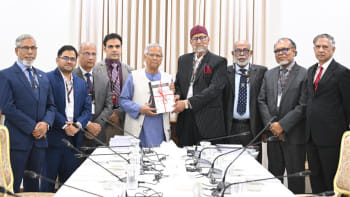Lead poisoning: The next big threat for Bangladesh

Bangladesh is grappling with one of the largest cases of lead poisoning in history, with millions of children being exposed to it every day. In Bangladesh alone, it is documented that more than 35 million children have blood lead levels that are quite a bit above the safe range. According to the Institute of Health Metrics Evaluation (IHME), Bangladesh now has the world's fourth highest rate of death due to lead exposure.
Globally, one in three children – more than 800 million children in total – has elevated blood lead levels (BLL). A recent study in Dhaka suggests that 80 percent of urban children have more than five micrograms per decilitre (µg/dl) of lead in their blood, which is above the WHO-recommended value. Another countrywide study suggested that 34 percent of children have more than 5µg/dl blood lead. This persisting high BLL among children needs special attention from government and non-government institutions.
There are additional sources and pathways of lead poisoning in lower-income countries compared to higher-income countries. For example, despite having an insufficient capacity in maintaining protective regulations and infrastructure, the use of lead in industry still persists in Bangladesh and other lower-income countries. At the industrial level, used lead acid battery (ULAB) recycling is a common source of hazardous emissions in semi-urban and rural Bangladesh. Until now, the toxic site identification programme (TSIP) identified more than 360 ULAB recycling sites, and the World Bank identified 1,100-plus such sites, bringing roughly a million people at risk. When abandoned, defunct ULAB recycling sites still pose a hazard to the surrounding communities – and can sometimes spread even further. ULAB recycling is also extraordinarily dangerous for workers, including child labourers who comprise about a quarter of the ULAB workforce.
Bangladesh is compliant with the WHO and has banned lead paint. However, enforcement remains limited – 30 percent of paints sold in the country exceed the threshold standard, and almost all of them contain very high lead concentrations (10,000 ppm). There is an ongoing movement to mobilise support for stronger controls and enforcement against the use of lead paint.

Lately, the adulteration of spices – particularly turmeric – has caused great concerns. A recent study identified widespread and intentional adulteration of turmeric with lead chromate in Bangladesh to highlight the colour, thereby increasing perceived quality and market price.
Turmeric adulteration and high blood lead levels have already been documented. Government officials have affirmed their intention to address this threat. Consequently, in 2020, the authorities took strong response measures, including restricting import of lead chromate. It has been argued that the government should set permanent import limits on lead chromate to mitigate turmeric adulteration. Screening of turmeric for lead is also urgently needed to identify and stop this practice. This should be done in alignment with generating more awareness among turmeric producers about the dangers of this practice and empowering consumers with more oversight of how the turmeric they buy is processed.
Furthermore, lead may also be found in various day-to-day products, such as local cosmetics, traditional herbal medicines, toys, aluminium cookware, and jewelleries. Although lead content in these products is anecdotally documented in the recent 2022 countrywide fact-finding explorations, limited evidence is available about the extent of lead contamination or the relative contribution to the national burden of lead poisoning.
There are diverse sources of lead poisoning in Bangladesh, and the relative burden caused by different exposure channels remains poorly understood. Lead exposure is not only more common in lower-income countries, but the adverse effects may also be more severe due to nutritional and environmental factors. Poor nutritional status, especially calcium and iron deficiencies, increases lead absorption and metabolism.
A variety of interventions are recommended based on the 2022 findings, including improved nutrition, correction of iron deficiency, community and family education, chemical chelation of products, and attempts to remove lead sources from children's environments. Adding blood lead levels in national surveillance would help monitoring, evaluation and research to inform policy and its implementation. We need continued investment in the reduction of lead exposure and government-level policy implementation nationwide.
Dr Mahfuzar Rahman is country director of Pure Earth in Bangladesh.

 For all latest news, follow The Daily Star's Google News channel.
For all latest news, follow The Daily Star's Google News channel. 








Comments